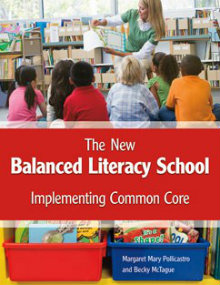Making a Case for New Balanced Literacy
The New Balanced Literacy School: Implementing Common Core
By Margaret Mary Policastro and Becky McTague
(Maupin House Publishing/Capstone, 2015 – Learn more)

Drs. Margaret Mary Policastro and Becky McTague passionately share their experiences and research findings regarding the New Balanced Literacy (NBL) model and how Common Core factors in, in their book The New Balanced Literacy School: Implementing Common Core.
The text ambitiously attempts to show us the need for the NBL school; identifies the characteristics of and the shifts necessary to implement the model; details leadership and organizational structures pertinent for successful implementation; and argues for the importance of school-wide collaboration by presenting a plausible framework for schools to follow.

That being said, once I began Chapter Two the floodgates of understanding blasted open, and I really began to relate to what was being discussed. I was able to better understand, and agree with, the notion that balanced literacy puts the focus back on language and on the critical and essential role it plays in every area of instruction (page 18).
Why and how to make shifts in pedagogy
The text shows us language in action and attempts to lay out for us how to shift our thinking and practices to create literate students in an ever-changing world. For one, classroom discourse is paramount, especially in the heavy shift towards argumentation.
Second, students need to practice skills with more complex texts and rigor, especially rooted in conversation and discourse within the classroom. Because, in order for higher leveling thinking and teaching to occur, teachers need to understand and determine best times to model, and when and how to step-in/step-out of discourse.
This text is great for grades 6-12 teachers (once you read Chapter 1 several times) because it not only explicitly details ideological pedagogy of K-5, but also determines the relevant shifts necessary for later grades in a balanced literacy approach. The text tells the reader what shifts need to occur and then goes so far as to detail how to make said shifts.
In addition to complex texts being a necessary shift, other important changes that the authors spend a good deal of time discussing are the needs for reading, writing, and speaking to be grounded in text evidence; and the building of knowledge through content-rich nonfiction. Undoubtedly, some of the most relevant ideas in current best-practice ideological frameworks are identified and related to the New Balanced Literacy School approach.
Libraries and language
One of the most important sections of the text shows the reader what a New Balanced Literacy School (NBLS) looks like. For one, there are libraries. Lots of them. Libraries not only for students, teachers, and schools, but also for parents. The authors go into great detail about how to create school libraries, including all of the necessary leadership and tangible components necessary for success. The authors use their personal experiences working with and in schools to help bring the NBLS to life. These shared experiences are helpful and relatable to understanding the role language plays in the success of a NBLS program.
Graphic organizers to monitor goals
Located throughout the text is an umbrella graphic that allows readers to visualize all of the components necessary for a NBL school to function. This and other graphic organizers will help teachers monitor instructional goals and time and assist in the establishment of classroom literacy routines. One organizer in particular (page 74) gives teachers a handy chart to utilize when scheduling class time. I can see this being a useful tool from the start of the year to see your week at a glance and to understand how it incorporates all of the pieces of the literacy puzzle. Also, many, many great ideas litter the text as resources to use during your school’s shift towards becoming a NBLS.
Although I feel that this book is definitely geared towards the K-5 grades (it’s designated K-8), it is absolutely relevant for the middle/high school environment as well. Policastro and McTague are passionate about this topic and authentically include real-world experiences in detailing how and why the New Balanced Literacy School is vital as we move toward full CCSS implementation.
Jennifer Wirtz has been a 7th and 8th grade English Language Arts teacher at Gemini Junior High School in Niles, Illinois for over a decade. She received a B.A. and a B.S. from Loyola University Chicago and a Masters in Education from DePaul University. Currently she is also finishing up a three year stint as a Design Teacher on the Project READI research project at the University of Illinois-Chicago. She is married to a math teacher and has two young children.


































